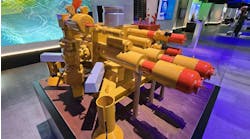Gurdip Singh
Contributing Editor
Re-configure, re-design, and re-engineer will be the by-words in the coming years as the global drilling industry modifies existing rigs to meet new standards resulting from BP’s Macondo blowout in the Gulf of Mexico. Under expected new upstream operating regulations, BOPs probably will be the most critical area for change, says a senior executive at Singapore rig builder Keppel FELS Ltd.
“The global oil and gas industry will have to make major changes to rigs to carry out hydrocarbon exploration in the coming years,” says Wong Kok-Seng, Keppel FELS executive director in an interview withOffshore.
These changes are widely expected after the recent BP oil leak, says Wong, pointing to the double-hull rulings enforced on tankers after the March 1989 ExxonValdez grounding in Prince William Sound, Alaska.
“Though right now there are no clear indications on what changes can be expected from the BP incident, our yards are ready to carry out major modification, re-configuration, re-design and re-engineering work on rigs if new standards are set for exploration activities in the Gulf of Mexico and elsewhere,” says Wong.
The recently completedENSCO 8503 is headed to the Gulf of Mexico.
An industry veteran with over 30 years’ experience managing fabrication of offshore marine facilities, Wong believes the offshore working environment for rigs will change with new regulations in the coming months, in the wake of the Deepwater Horizon incident.
Wong is looking critically at changes in rigs’ BOP installation facilities, capacities, and capabilities. While he reviews various aspects of rig building at Keppel FELS, two of the yard’s recently built deepwater rigs have been re-permitted for drilling in the Gulf of Mexico post-oil spill.
“ENSCO 8500 and ENSCO 8501 are the first two deepwater rigs to be certified by the Bureau of Ocean Energy Management Regulation and Enforcement (BOEMRE) under NTL No. 2010 – NO5 in the U.S. Gulf of Mexico under the new regulatory framework,” he says.
Keppel FELS has built four of seven identical ENSCO 8500 Series rigs for Ensco Plc. The third rig,ENSCO 8502, delivered in January, has passed the US Coast Guard marine safety tests with a perfect score, says Wong. The fourth unit, ENSCO 8503, was completed this past August and also is bound for work in the Gulf of Mexico. The rig is scheduled to commence a two-year primary term with Cobalt International Energy L.P. in early 2011. Keppel FELS plans to deliver the rest of the rigs in the years leading to 2012.
While Keppel FELS is busy through to 2012-2013 with rig building orders, its sister company Keppel Shipyard is confident of a recovery in new orders for floating production units.
“We expect to see a new wave of demand for FPSO units,” says Nelson Yeo, managing director for the marine business at Keppel Offshore & Marine and managing director of Keppel Shipyard.
The market is picking up after the 2008 financial crisis and the company is preparing for new orders at shipyards in Singapore as well as sister yards.
Yeo says Keppel O&M will continue to seek new opportunities as a corporate strategy to build Keppel’s core business in the offshore and marine sectors.
Preparation ahead of the next wave for new orders is a must, he stresses. “Projects do not go away, but they do get postponed and re-scheduled; the world will continue to require oil and gas for energy and ships for trade transportation.”
Yeo underlines Keppel’s global role in serving the oil and gas sector, including the tanker and offshore vessel segment, the FPU/FPSO segment, and the drilling rigs.
“Our service may sometimes appear to cost more in the beginning but we delivered on time with dependability,” says Yeo, adding that this is what the high-risk/high-reward oil and gas industry wants. “We are building production facilities for long-term uninterrupted production of oil and gas fields. Any compromise on quality of such multi-million dollar facilities by operators could turn out later to be very costly.”
Yeo sees the global oil and gas industry becoming more selective in appointing major contractors to build offshore facilities. Keppel, he points out, is among the leading contractors and has won its place through decades of experience.
Separately, Keppel FELS has started building its first vessel dedicated to installing offshore wind turbines in the North Sea. The $220-million, multi-purpose, self-elevating vessel is in partnership with the Seafox Group and should be operational from 2012. It is an example of Keppel diversifying into energy facilities. Keppel FELS’ Wong expects to build more such specialized vessels as development of offshore wind energy picks up in the coming years.
Keppel Shipyard is currently working on six FPSOs, two drillships for Frontier/Shell joint venture, and a number of other projects.
Keppel worldwide is working on S$5 billion ($3.7 billion) in orders with deliveries through to 2013.
Offshore Articles Archives
View Oil and Gas Articles on PennEnergy.com




